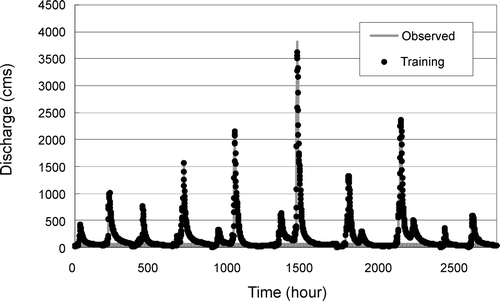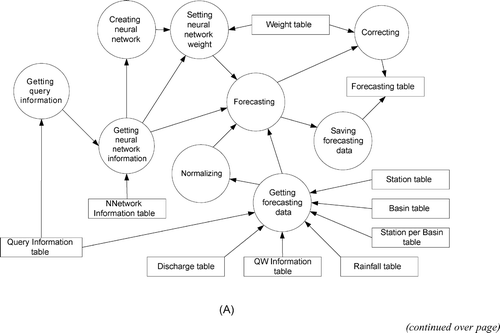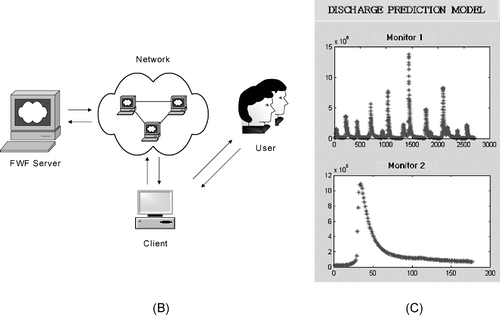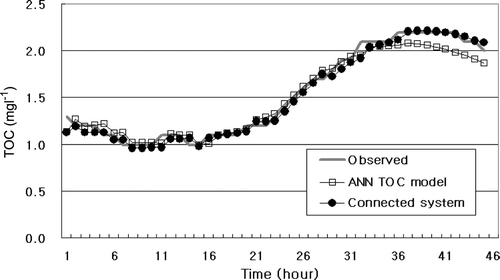Abstract
It is advantageous to take simultaneous measurements of discharge and water quality at the same station for real‐time management of water quality. However, some of the continuous water quality monitoring stations can be located some distance from the water level stations; and the case of the Pyeongchang River is one such in South Korea. The major monitoring parameter in water quality is total organic carbon. In this study, an artificial neural network model was constructed for discharge prediction at the continuous water quality monitoring station. This model was connected to another model that forecasts total organic carbon. The connected system showed better results than the single model in the forecasting of total organic carbon.
Introduction
As the water quality of a river keeps changing with time and space, continuous water quality measurements and analyses are necessary for effective management. The amount of transported pollutant is affected by discharges to the river. Therefore, the relationship between the discharge and the water quality must be taken into consideration. However, water quality data are normally calculated from measurements that are taken at different times or periods to those of discharge measurements. More accurate data can be efficiently derived if the water quality and discharge are connected by measurements taken at the same time at the same station.
Acquiring accurate data on real‐time discharge and water quality is difficult because the volume of discharge often varies. The continuous water quality monitoring station on the Pyeongchang River in Korea is a place which needs a more accurate real‐time assessment of discharge since the discharge measurement stations are located at distant locations. In addition, establishment of a system to monitor the quality of the water source and to provide an earlier warning is necessary because a water intake facility for water supply to a population of more than 100,000 people is located downstream. The major monitoring item is total organic carbon (TOC).
The water quality and discharge continuous measurement stations are usually not at the same place even though the discharge is a very important factor which considerably affects the water quality. Though the condition of water fleas is used to determine the degree of water pollution, more efficient ways are required to help the judgment of the managers through the integration of proper analysis and prediction models. The Artificial Neural Networks (ANN) model can be used for real‐time water quantity and quality management, because it is easy to construct and adjusts well to changes through learning.
There has been a review on the use of ANNs for predicting and forecasting water resource variables [Citation1]. Recently, numerous ANN‐based rainfall‐runoff models have been proposed to forecast streamflow [Citation2–Citation5] and water quality [Citation6–Citation9]. Neuro‐fuzzy computing using hybrid learning algorithms has been proposed for modeling time series [Citation10,Citation11].
There are no continuous discharge data at the continuous water quality monitoring station which is located far from the tele‐meta (T/M) water level stations. In the T/M station, the data of water level are being translated automatically. In consideration of this, a discharge model was constructed to calculate discharge at the continuous water quality monitoring station in the Pyeongchang River. This discharge model was linked to a TOC forecasting model. This established forecasting system was tested as to whether it was more efficient than the single TOC forecasting model.
Materials and method
Object basin and data
The data on hourly rainfall at the T/M water level station and the data on discharge converted from the hourly water level at the T/M water level station are necessary for the learning and prediction of the discharge model. The hydrological data were collected from the data base (D/B) of the Han River flood control center and the Korea Water Resources Corporation (K‐water). The records of the 14 rainfall gauging stations within the basin were calculated with areal rainfall by the Thiessen method. The records of the water level at the Panwoon and Yeongwol T/M water level stations were converted into discharge data using a rating curve.
The continuous water quality monitoring station, which is an ungauged station for discharge, is located between the Panwoon water level station and the Yeongwol water level station at the Pyeongchang River as shown in Figure . The Jucheon River flows into the Pyeongchang River upstream of the continuous water quality monitoring station.
Figure 1 Pyeongchang River basin. The continuous water quality monitoring station (Pyeongchanggang station) is located between the Panwoon and the Yeongwol water level stations.

The data were collected between 1997 and 2003, and Table shows the characteristics of the hydrological data at the Panwoon and Yeongwol water level stations.
Table 1. The characteristics of the hydrological data at the Panwoon and Yeongwol water level stations.
Artificial neural network model
The superiority of the Levenberg‐marquardt method over ordinary BP (Back Propagation) algorithms has been proved through various research studies. This type of learning is referred to as a supervised mode of learning [Citation9,Citation10]. The objective of learning is to reduce the error between the neural network’s predictive outputs and the target outputs until a prescribed error criterion is met. The learning process is accomplished by using the back propagation algorithm. Standard back propagation is a gradient descent algorithm. One iteration of this algorithm can be written as
where x k+1 is a vector of current weights and bias, gk is the current gradient and αk is the learning rate.
Here, we used a quick learning algorithm, the Levenberg‐marquardt algorithm. It efficiently controls the size of η which is calculated repeatedly by using the Levenberg‐marquardt update rule as shown in Equation (Equation2) to adjust the weight as in:
where J is the Jacobian matrix of the error differential for each weight, η is the rate of adjustment learning, and e is the error vector. One iteration of this algorithm can be written as
When the scalar η is zero, this is just Newton’s method, using the approximate Hessian matrix. When η is large, this becomes a gradient descent with a small step size. Newton’s method is faster and more accurate near an error minimum, so the aim is to shift toward Newton’s method as quickly as possible. Thus η is decreased after each successful step (reduction in performance function) and is increased only when a tentative step would increase the performance function. In this way, the performance function will always be reduced at each iteration of the algorithm.
Application and results
Application of discharge prediction model
The ANN was applied for the real‐time prediction of discharge and for the forecasting of TOC. It involved some important factors such as the discharge characteristics on the upstream and downstream and the total hourly rainfall in the ungauged basin. These factors were considered in the calculation of the discharge at the continuous water quality monitoring station where a real‐time recording of the water level is not made. The total hourly rainfall was calculated by the amount of areal rainfall that was assessed from the hourly rainfall data. It was attempted to learn the relationship of the size of the basin area and discharge to the volume of rainfall for an hour in a random basin.
As the continuous water quality monitoring station at the Pyeongchang River is located a long distance away from the Yeongwol T/M water level station, an accurate real‐time calculation of discharge is not possible. What can be obtained at the continuous water quality monitoring station with an ungauged station is the record of rainfall at the T/M rainfall gauging station. A prediction of discharge according to the volume of rainfall has to be made. Therefore, the input data were composed of the discharge (t) at the Panwoon station located in upstream from the continuous water quality monitoring station, the discharge (t) at the Yeongwol T/M water level station located downstream, and the total rainfall (t) at the continuous water quality monitoring station to output the discharge (t+1) at the continuous water quality monitoring station. The constructed neural network model for the prediction of outflow learned to interpret the relationship between the total volume of rainfall and discharge as shown from step 1 to step 10 in Table .
Table 2. Process of discharge model for learning and prediction.
The learned mapping was applied to five runoff events between July 1995 and July 2001. The result of the learning is shown in Figure .
Construction of networking and graphical user interface (GUI)
The neural network model is linked to the server that supply data. A GUI was constructed for the learning and prediction monitoring using Matlab ver. 5.0. The computer screen was divided into the two parts, as shown in Figure . One is the learning monitor (monitor 1); the other is the prediction monitor (monitor 2). After learning, we could find the predicted discharge at Pyeongchanggang station in every case.
Connecting discharge prediction model with the TOC forecasting model
Total organic carbon forecasting was performed by the ANN model and by the connected system. The construction of the models is shown in Table . Continuous acquisition of the discharge data is necessary in addition to the water quality data for the real‐time forecasting and management of water quality. However, the continuous water quality monitoring station and the T/M water level station are located some distance apart, which makes it difficult to obtain accurate real‐time data on discharge and water quality. A more accurate real‐time calculation of discharge is necessary to set up an effective system for observation and management in the continuous water quality monitoring station at the Pyeongchang River. For this purpose, the model for the prediction of discharge was constructed to have a smooth linkage with the model for TOC forecasting. The connected system was applied to the continuous water quality monitoring station at the Pyeongchang River which has an ungauged station for discharge.
Table 3. Construction of ANN models.
The model for the prediction of discharge was constructed to output the discharge at ungauged stations through learning of the hydrological data at the Panwoon and Yeongwol stations located upstream and downstream, respectively. The TOC forecasting of the connected system was performed by the automatic input of the output value of the discharge prediction model. The process is shown in Figure . The predicted output of discharge is inserted into the TOC forecasting model. The TOC forecasting model, which is used for stochastic research [Citation12], was a neural networks model.
Figure 4 Construction of connected system. The discharge prediction model learned to interpret the relationships between the total rainfall and discharge, and the predicted discharge was used as the input data for the TOC forecasting model.

Figure shows forecasted TOC concentrations. The observed results were compared with the values forecast by the connected system and by the ANN TOC model. The RMSE of the connected system was 0.07 mg l−1 and the RMSE of the ANN TOC model was 0.09 mg l−1. The connected system showed a smaller standard deviation. The connected system showed better results than the ANN TOC model. The correlation coefficient (CC) was the same for both systems at 0.99. Some useful results of the TOC forecasting were obtained through a more accurate calculation of discharge by linking the discharge prediction model to the TOC forecasting model. Thus, the operation of facilities for continuous discharge measurements, as well as an effective method for calculation of the amount of outflow, is required. Moreover, improvement to the structure and accuracy of the prediction model is considered to be necessary for the stable simulation at points of considerable change in water quality.
Conclusion
A prediction of discharge with the neural network model was performed at the continuous water quality monitoring station at the Pyeongchang River, which has an ungauged station for discharge. We could find the predicted discharge through the networking server and constructed GUI. The information on flood runoff can be obtained from the server and accepted data can be used for the prediction.
The discharge prediction model was connected to the TOC forecasting model to review the effect of improvement. This connected system learned the discharge that was calculated at the continuous water quality monitoring station, while the ANN TOC model learned the discharge which is calculated at the Yeongwol station downstream. The results of the TOC one‐hour forecasting at the continuous water quality monitoring station were that the connected system showed fewer errors by calculating the discharge more accurately so that it approximated to the observed value. The results of RMSE using the connected system were analyzed and demonstrated that the connected system showed improved forecasting.
From this result, we can reconfirm the verification that discharge is an important factor for the analysis of water quality. The statistical or stochastic model is thought to be applicable in the future for the real‐time prediction and management of discharge at ungauged stations where accurate measurement of discharge is not possible.
Acknowledgements
This research was supported by the 2005 Specialized Priority Program for Disaster of Kangwon National University.
References
- Maier , H.R. and Dandy , G.C. 2000 . Neural network for the prediction and forecasting of water resource variables: A review of modeling issues and applications . Environ. Modell. Softw. , 15 : 101 – 124 .
- Hsu , K.L. , Gupta , H.V. and Sorooshian , S. 1995 . Artificial neural network modeling of rainfall‐runoff process . Water Resour. Res. , 31 : 2517 – 2530 .
- Smith , J. and Eli , R.N. 1995 . Neural network models of rainfall runoff process . J.Water Resour. Plann. Manage. – ASCE , 121 : 499 – 508 .
- Zealand , C.M. , Burn , D.H. and Simonovic , S.P. 1999 . Short‐term streamflow forecasting using artificial neural networks . J. Hydrol. , 214 : 32 – 48 .
- Kisi , O. 2007 . Streamflow forecasting using different artificial neural network algorithms . J. Hydrol. Eng. , 12 : 532 – 539 .
- Maier , H.R. and Dandy , G.C. 1996 . The use of artificial neural networks for the prediction of water quality parameters . Water Resour. Res. , 32 : 1013 – 1022 .
- Zhang , Q. and Stanley , S.J. 1997 . Forecastiong raw‐water quality parameters for the north Saskatchewan river by neural network modeling . Water Res. , 31 : 2340 – 2350 .
- Ha , H.J. and Stenstrom , M.K. 2003 . Identification of land use with water quality data in stormwater using a neural network . Water Res. , 37 : 4222 – 4230 .
- Chaves , P. , Tsukatani , T. and Kojiri , T. 2004 . Operation of storage reservoir for water quality by using optimization and artificial intelligence techniques . Math.Comput. Simulat. , 67 : 419 – 432 .
- Jang , J.S.R. , Sun , C.T. and Mizutani , E. 1997 . “ Neuro–Fuzzy and Soft Computing ” . Upper Saddle River, NJ : Prentice Hall International .
- Nayak , P.C. , Sudheer , K.P. , Rangan , D.M. and Ramasastri , K.S. 2004 . A neuro‐fuzzy computing technique for modeling hydrological time series . J. Hydrol. , 291 : 52 – 66 .
- Yeon , I.S. , Kim , J.H. and Jun , K.W. 2008 . Application of artificial intelligence models in water quality forecasting . Environ. Technol. , 29 : 625 – 631 .



